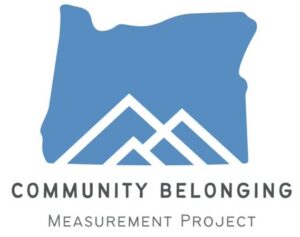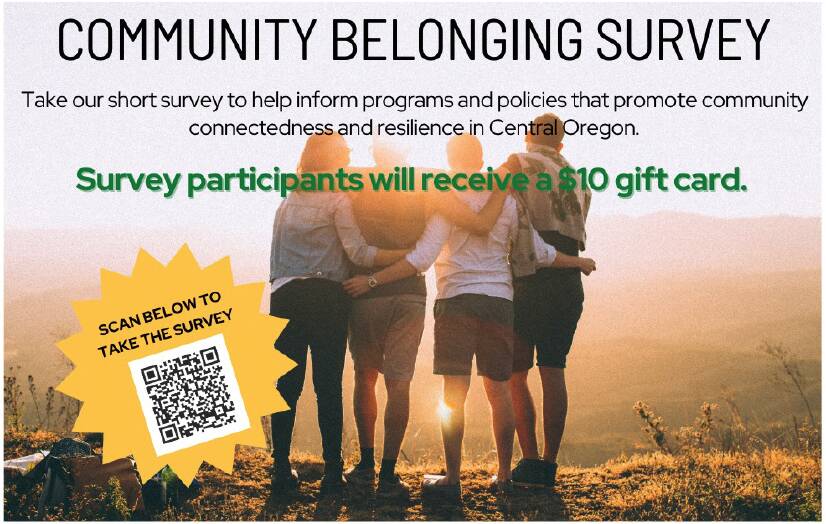Translational Science Benefits
Summary
A sense of belonging has long been considered a basic human need, and it is crucial for physical and mental health.1,2 Belonging is defined as the personal feeling of value and respect that a person gains from sharing experiences and characteristics with others.3 A sense of belonging has been linked to many positive health outcomes and improved quality of life.4,5 Groups that have experienced discrimination or oppression, older adults with smaller social networks, and individuals living in rural areas may all lack a sense of community belonging.6,7 COVID-19 lockdowns and safety measures have caused many social consequences for most people, but there has been increased isolation for older adults and individuals with disabilities in particular.8,9 These pressures highlight the urgent need to understand and promote community belonging.

The “Measuring Resilience and Belonging in Central Oregon” project was created to assess community belonging in Central Oregon. The region has 250,000 residents and includes Deschutes, Jefferson, Crook, and North Klamath communities, as well as the confederated tribes of Warm Springs. This project is part of a larger strategy that uses data to help develop health priorities in Central Oregon and facilitate community-engaged research and community-academic research partnerships. The research team included researchers from Oregon Health & Science University (OHSU) and Oregon State University (OSU)–Cascades, in close partnership with the community. To conduct this work, an OHSU liaison lived and worked in the community for many years to build trust and engage community members in meaningful decision-making and strategic planning. The study used a mixed methods approach. The team used surveys and focus groups measured belonging in a representative sample of an adult population; these findings were assessed with quantitative descriptive statistical analyses and qualitative thematic analyses.10 Community partners collaborated in each phase of the study, from planning through dissemination.
Significance
The research team put together a report of their findings for the Central Oregon Health Council (COHC), a regional legislating committee. With this information, the council can pass data-driven health policies and programs for their constituents. In addition to gathering testimony from researchers, the COHC conducts other data-collecting activities like the Regional Health Assessment. Findings from this project could inform modifications to the Regional Health Assessment and may help elevate the importance of the issue of belonging for priority populations. Finally, the research findings may also inform the COHC’s Policy Improvement strategy, which is part of their Regional Health Improvement Plan (RHIP).

The project’s process is as important as its expected impact and benefits. The Community Research Liaison (CRL) developed and maintained relationships with local partners over several years, which built trust and promoted collaborations between community and academic researchers. The CRL’s relationship-building was integral for this and successive collaborations and partnerships.11,12
Community members were heavily involved in the planning process. For example, they developed the definition of “belonging” used in the survey and focus groups. Community members also contributed to data analysis and dissemination phases. They provided suggestions for improved data collection as well as culturally responsive interpretation and analysis of the data. Recommendations from community members guided the use of data by government agencies and community organizations that might provide funding opportunities. The meaningful engagement of community members is important in promoting equitable processes and outcomes for priority populations.
Benefits
Demonstrated benefits are those that have been observed and are verifiable.
Potential benefits are those logically expected with moderate to high confidence.
Community partners participated in all stages of the research, including planning, data collection and analysis, and dissemination. demonstrated.
Community
Research findings may lead to new health services aimed at improving mental health and social relationships in prioritized populations. potential.
Community
Research findings may improve existing healthcare interventions for improving belonging and wellbeing. potential.
Community
Data-informed programs and projects stemming from this research will improve mental health and social relationships in prioritized populations. potential.
Community
Regional funders can create programs informed by the research findings to improve belonging and resilience in prioritized populations. potential.
Community
The results of this study will be used to inform the Regional Health Assessment for the Central Oregon Health Council, a regional governing committee. potential.
Policy
Researchers presented preliminary data to the Central Oregon Health Council and plan to present full findings to other local government organizations. demonstrated.
Policy
Findings from this study will inform the Central Oregon Health Council’s Policy Improvement strategy, part of their Regional Health Improvement Plan. potential.
Policy
This research has community and policy implications. The framework for these implications was derived from the Translational Science Benefits Model created by the Institute of Clinical & Translational Sciences at Washington University in St. Louis.13
Community
This project’s activities, including partnership development and regular meetings, deeply strengthened relationships between the research team and community partners. Community partners assisted the research team in outreach efforts for survey distribution, resulting in 1000 survey responses and 40 focus group participants. To better understand the research’s preliminary findings, the research team co-facilitated conversations alongside community partners with community members from priority populations to identify trends and patterns. Following these meetings, community partners helped develop final products and assisted in research dissemination efforts. The community co-facilitators were encouraged to collaborate with their own organizations to use the research findings to inform program, policy, and initiative development, prioritizing a sense of belonging and community health improvement.
The research team partnered with the St. Charles Health System to share study findings with community organizations that work to reduce social isolation and increase a sense of belonging. The St. Charles Health System has also funded re-measurement efforts to understand the impact of such programs focused on community belonging.
Policy
In its 2020-2024 Regional Health Improvement Plan, the COHC identified a regional measure for belonging and resilience as a future state metric to guide their work to improve health outcomes in the region. COHC funded this project to establish a baseline measure of belonging. RHIP workgroups can use this baseline to measure impact the of local programs and policies. Researchers have presented updates and findings to COHC community advisory committee and workgroups, and to other community groups, so that the data may inform their future funding initiatives and collective action efforts. The research team has also received tailored requests for data from local government organizations for future planning and decision-making. Researchers also disseminated findings and lessons learned at local and national public health association conferences.
Lessons Learned
Community-engaged research is innovative, and its benefits are far reaching, but it is not a fast process. Researchers engaged in a collaborative, iterative process throughout the project timeline, engaging community members in processes, data gathering, data analysis and interpretation, and dissemination. Having buy-in from partners in the analysis phase not only increases data quality, but also increases the likelihood that their local communities will actively use the data in local decision making. The Community Research Liaison also continually built relationships throughout the project.
- Baumeister RF, Leary MR. The need to belong: desire for interpersonal attachments as a fundamental human motivation. Psychol Bull. 1995;117(3):497-529.
- Maslow AH. The instinctoid nature of basic needs. J Pers. 1954;22(3):326-347. doi:10.1111/j.1467-6494.1954.tb01136.x
- Mahar AL, Cobigo V, Stuart H. Conceptualizing belonging. Disabil Rehabil. 2013;35(12):1026-1032. doi:10.3109/09638288.2012.717584
- Carpiano RM, Hystad PW. “Sense of community belonging” in health surveys: what social capital is it measuring? Health Place. 2011;17(2):606-617. doi:10.1016/j.healthplace.2010.12.018
- Kitchen P, Williams A, Chowhan J. Sense of Community Belonging and Health in Canada: A Regional Analysis. Soc Indic Res. 2012;107(1):103-126. doi:10.1007/s11205-011-9830-9
- Allen KA, Kern ML, Rozek CS, McInereney D, Slavich GM. Belonging: A Review of Conceptual Issues, an Integrative Framework, and Directions for Future Research. Aust J Psychol. 2021;73(1):87-102. doi:10.1080/00049530.2021.1883409
- Lincoln AK, Cardeli E, Sideridis G, et al. Discrimination, marginalization, belonging, and mental health among Somali immigrants in North America. Am J Orthopsychiatry. 2021;91(2):280-293. doi:10.1037/ort0000524
- Lund EM, Forber-Pratt AJ, Wilson C, Mona LR. The COVID-19 pandemic, stress, and trauma in the disability community: A call to action. Rehabil Psychol. 2020;65(4):313-322. doi:10.1037/rep0000368
- Wu B. Social isolation and loneliness among older adults in the context of COVID-19: a global challenge. Glob Health Res Policy. 2020;5:27. doi:10.1186/s41256-020-00154-3
- OCTRI_PDF_CORE_Belonging_2022 08 16.pdf. Accessed December 5, 2023.
- Farris P, Crist R, Miller S, Shannon J. Rural research capacity: a co-created model for research success. Health Res Policy Syst. 2023;21(1):76. doi:10.1186/s12961-023-01030-5
- Jäderholm C, Currier J, Brown K, et al. The Community Research Liaison Model: Facilitating community-engaged research. J Clin Transl Sci. 2023;7(1):e78. doi:10.1017/cts.2023.31
- Luke DA, Sarli CC, Suiter AM, et al. The Translational Science Benefits Model: a new framework for assessing the health and societal benefits of clinical and translational sciences. Clin Transl Sci. 2018;11(1):77-84. doi:10.1111/cts.12495

